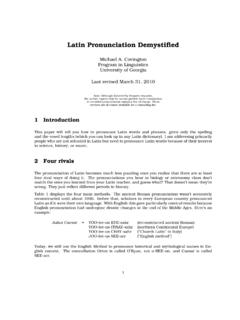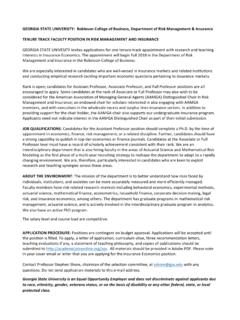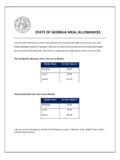Transcription of Georgia Forest Facts
1 Forest LandOf Georgia s 37 million acres of land area, million acres is Forest land. Of this million acres, million acres is timberland available for commercial use - more than any other state in the nation. The state s Forest lands provide a myriad of benefits to citizens, including clean air and clean water. With two out of every three raindrops falling in Georgia landing on Forest lands, our forests are one of the most significant factors affecting our water quality and Inventory and Analysis, US Forest Service 2011 Contribution to the EconomyGeorgia s Forest industry is the second largest industry in the state in terms of employment and wages and salaries.
2 Forest -related industries inject $ billion and 108,112 jobs into the state s economy, making it Georgia s second largest manufacturing employer. Compensation for Forest industry employees and supporting businesses exceeds $ billion per year, and Forest management and supply to mills by landowners and Forest managers generate $900 million in output (mill gate value).Economic Benefits of the Forestry Industry in GeorgiaGeorgia Institute of Technology - 2010 ReportGeorgia Forest FactsGeorgia s forests have the capacity to meet increased demands for goods and services now and in the future. But the correct mix of stewardship, market opportunities and commitment to public policy must come together to support Forest landowners, organizations and communities that hold these forests in trust for future OpportunitiesGeorgia s Forest resources are capable of providing a variety of additional opportunities for the state.
3 One of the most profound opportunities lies with the emerging bioenergy industry, of which Georgia is considered a leader. Forbes magazine ranked Georgia third in the nation for potential biomass energy as measured by the amount of biomass available in the state. Bioenergy projects in Georgia have the potential to add thousands of additional jobs within the new facilities and forestry operations to support them. The marketing of Georgia s traditional Forest products and developing new bioenergy products will increase the value of forests and encourage reforestation and good management practices.
4 The Forest industry provides an average of $448 million in state tax revenues each year. There are 151 wood processing mills in Georgia , including 12 pulp mills, 85 sawmills and 54 other mills. An estimated 47 Georgia counties are ranked as critically dependent, very dependent or moderately dependent on the Forest products industry in terms of to Georgia CitizensGeorgia s Forest lands provide immense value to citizens throughout the state in the form of essential ecosystem services - clean water, carbon storage, wildlife habitat and aesthetics. A report by the University of Georgia found that these ecosystem services are worth an estimated $37 billion annually.
5 This is in addition to the value of timber, Forest products and recreation. Forest Inventory and Analysis, US Forest Service 2010 OwnershipThe majority of Georgia s timberland is owned by private non-industrial ThreatsForest issues ranked most critical by the public and identified in the Statewide Assessment of Forest Resources include a number of threats which present significant challenges to Forest managers, landowners and policy makers. They are interrelated and often complex: Water quality and quantity Urbanization Forest health Biodiversity Air quality Fire management Fragmentation and parcelization Economics and changing markets Mitigating risks associated with these threats to Georgia s forests is a priority for GFC.
6 For more information on these threats, download the Statewide Assessment of Forest Resources at are a renewable resource providing clean air, clean water and abundant products. Georgia s forests are being sustainably managed to meet the growing needs of citizens. With the wise use of knowledge and resources, Georgians can keep our forests sustainable for present and future generations. Georgia s commercial timberlands grow 19 million tons more wood each year than is harvested, resulting in growth exceeding removals by 38 percent. Georgia s timberland coverage has remained stable since the 1950s.
7 Forest losses in metro areas have been offset by converting old farm lands back to Forest lands in other parts of the state. Because the net growth of our forests has consistantly exceeded net removals, the volume of timber in Georgia is greater now than it was in the 1930s!The Georgia Forestry Commission (GFC) is a dynamic state agency responsible for providing leadership, service and education in the protection and conservation of Georgia s Forest Equal Opportunity Employer and Service








